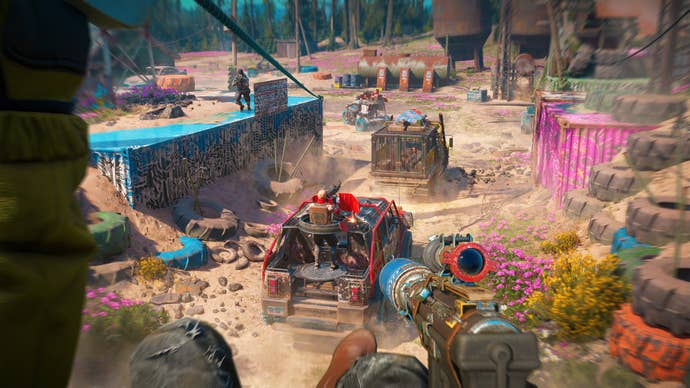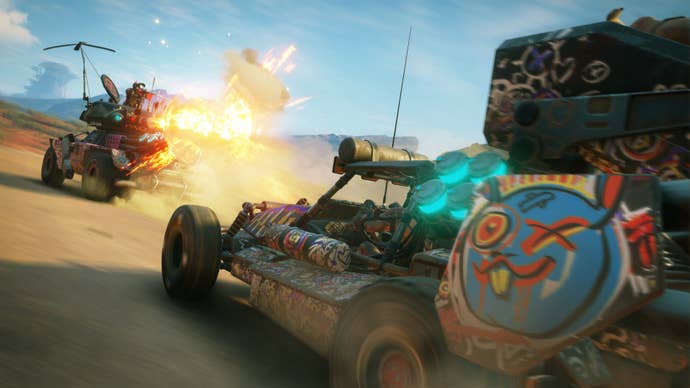Technicolor Dystopias: Why the Colorful Wastelands of Rage 2, Far Cry New Dawn, and Fallout 76 Are Suddenly Popular
We talk to the developers behind these colorful post-apocalypses and explore the history behind the trend.
This article first appeared on USgamer, a partner publication of VG247. Some content, such as this article, has been migrated to VG247 for posterity after USgamer's closure - but it has not been edited or further vetted by the VG247 team.
"The experience of reading such a work is too much like staring into one’s own grave," writes Paul Brians of painfully realistic nuclear war fiction. And he would know; he literally wrote the book on it. Instead, we’re much more likely to embrace media depictions the internet has classified with the hashtag #NukePorn: glorified anarchic playgrounds set after everything's gone to hell.
A slew of recent games has embraced this concept in design, casting off the dull settings of dystopias past and instead casting global ruin in bright purples and neon pinks. A study of the genre's history would suggest this acts as a mechanism to control our anxieties over it actually happening. However, the technicolor settings of titles like Fallout 76, Far Cry New Dawn, and Rage 2 have taken #NukePorn to an unprecedented extreme.
For fans of classic titles, these colorful interpretations are hardly anything new. Graphical limitations resulted in several '80s games like Atari's Missile Command and Interplay's Wasteland using bright primary colors to illustrate the nuclear holocaust. Just getting players to be able to make out individual characters and scenery required extreme contrast. By the end of the '90s, however, the original Fallout's release established what would become the genre's dominant color palette in the decades to come: either dark gray, dark brown, or covered in trash.

The teams behind Fallout 76 and New Dawn specifically set out to buck this trend, and while the wastelands of the recently released Rage 2 may have been caused by a comet rather than nuclear bombs, its style unmistakably follows this model as well. Developers and artists from Bethesda, Ubisoft Montreal, and id Software have all emphasized a desire to stand out as a driving design direction for their respective games.
"From the start, we knew we wanted something different and unique," New Dawn's art director, Isaac Papismado, tells USG. "Building a colorful and inviting world was our number one priority." Set 17 years after nuclear bombs devastated the world, New Dawn's post-apocalyptic Montana countrysides appear cast in dazzling pinks and purples with colorful flora and fauna retaking the environment. Rage 2 features a similar palette, so much so that the team teased Ubisoft Montreal about it in a tweet earlier this year.
Inspiration for New Dawn's take on the end of the world came from an unexpectedly lively source: California's super bloom, a rare phenomenon where millions of wildflowers blossom at once along the state's southern hills. Turns out Instagram crusaders weren't the only ones captivated by the once-in-a-decade event.
"Our visual identity was built upon it and its vibrancy influenced the creation of the rest of our world," Papismado says, which explains the game’s penchant for neon colors. It's a bold choice, but one fans seem to appreciate given how many in the community post their snapshots captured using New Dawn's photo mode. He can't help but smile at the content the community frequently creates, sharing their discovery of sites like an old-world jail doused in pink paint, a dilapidated dome that used to house the county’s radio station, or any one of the game's many buildings graffitied with art as intricate as it is vibrant.
"It's mind-blowing to see how they've embraced this new refreshing look for a genre normally portrayed in a very dark manner," he says.

Similarly, Fallout 76's color palette was decided before the team had even chosen a location. "[W]e wanted to have the feeling of a world that was on the edge of falling into ruin, but it wasn’t quite there yet," lead artist Nathan Purkeypile explains. As such, setting the game shortly after nuclear bombs fell—a stark departure from other Fallout titles—became the cornerstone of its design.
When exiting Vault 76 for the first time, players wander into forests that look nearly identical to those of West Virginia in the fall, give or take a radroach or two. Unlike New Dawn, though, Purkeypile says the team sought to capture a gradient of decay through an array of environments. "We knew players would spend a lot of time in this world, so having that variety was essential to keep things interesting and to also feel more like a real place that spreads over a large area."
Waypoints like the industrial and chemically soaked Toxic Valley are reminiscent of previous Fallout titles, while others like the idyllic Whitespring Resort serve as a stark contrast with its perfectly manicured lawns. Ironically, this last location gets nuked by players more often than anywhere else in the game according to Purkeypile. They apparently love instigating the kind of wanton destruction they've seen in other Fallout games.
"The main goal with the other elements of the game was to reflect that diversity and iconic nature that the environment has," he says, which is why Appalachia's enemies like the Grafton monster, mega sloth, and the oft-memed Mothman each sport a "memorable hook" to their design.
A similar sentiment defines the environments in each of these three titles: the developers' desire to create a dystopia players haven't yet experienced. No simple task given the intimidating volume of books, movies, and other games that have left their mark on our collective cultural consciousness.
"The post-apocalyptic setting is such a popular one and has been explored by various entertainment mediums. Everyone has their idea of what that kind of world should look like," says Papismado. "In true Far Cry fashion, we wanted to flip the genre on its head and really surprise our players by inviting them to explore a new type of post-apocalyptic world."
However, while these design decisions may have been a way to stand out in a marketplace crowded by open-world games and post-apocalyptic fiction, their release proximity demonstrates the cultural significance of these colorful interpretations of the end of the world.
Escape to the Apocalypse
Fictional depictions of landscapes destroyed by nuclear war tended to embrace brutal realism in the decades following World War II, but that tradition faded as the use of nuclear bombs slowly transitioned out of memory and into the history books. Modern creators have typically ignored the immediate impact of the bombs in favor of dissecting the societies and systems built in the destruction's aftermath. Tales of survivors rarely concentrate on direct victims of the blast, often avoiding graphic detail of the human cost of exposure to such massive amounts of radiation. HBO's recent mini-series Chernobyl is one of the few pieces of modern media that hasn't shied away from such gruesome realism.
"Writers do not flinch from depicting the savagery and violence of the post-nuclear war age, but they are not eager to describe the moment of impact or to explore the rubble left behind," writes Brians in his novel Nuclear Holocausts: Atomic War in Fiction. "Metaphor too often becomes a tool for evading realism, moderating the horror by transforming it into artifice."
In this vein, modern post-nuclear fantasies like the Fallout series along with all manner of dystopian fiction from Mad Max to The Last of Us have crafted a simulacrum of the end of the world in our culture. Our understanding of the apocalypse, and particularly nuclear fallout, has been shaped by media's history of manipulating it, rewriting our expectations and defining a new reality.
So it's no surprise that games like New Dawn, Fallout 76, and Rage 2 treat such objectively morose settings as Wild West style playgrounds. By redefining our conception of the end of the world, our anxieties about it actually occurring become easier to manage. Given the cataclysmic headlines of most daily news chatter, it's no wonder players want a reprieve.

"The actual situation after a nuclear war or other global disaster would be squalid refugee camps and epidemics of disease and depression, far from the heroic individual or small team shoot-ups of games," Spencer Weart, a historian who has written extensively on how nuclear fear manifests in culture, tells USG.
Until recently, though, these thinly disguised power fantasies didn't look the part. With these three recent titles, wandering post-apocalyptic wastelands now feels more like a return to a pastoral ideal than any kind of cautionary parable of human avarice. According to Weart, the neon color palette may help "set them firmly in a fantasy setting far from the unsettling reality of our possible future." Almost as if a world increasingly defined by its daily chaos—terrorist activity, climate change, political insanity—has pushed our culture's apocalypse fetishism to the extreme.
The intensity of these cultural anxieties has transformed nuclear and dystopian fiction from a way to wrench control over our fears of the world ending into a fantasy of what it signifies: a new start. "[R]ather than creating the end of the world, we really wanted to portray the genesis of a new world," says Papismado. Though these kinds of stories have never shied away from glorifying the after effects of the apocalypse, titles like New Dawn, Rage 2, and Fallout 76 don't bother with the kind of melancholic allegories and nostalgia of previous entries in the genre. As if to say, there's no reason to fear the end of the world: it's gorgeous.

